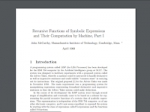
Chatbot listing, virtual agents, virtual assistants, chat bot directory, conversational agents, virtual human news, chatterbot list
NEWS: Chatbots.org survey on 3000 US and UK consumers shows it is time for chatbot integration in customer service!read more..
Universal Turing machine
 In this article, we first describe a formalism for defining functions recursively. We believe this formalism has advantages both as a programming language and as a vehicle for developing a theory of computation. Next, we describe S-expressions and S-functions, give some examples, and then describe the universal S-function apply which plays the theoretical role of a universal Turing machine and the practical role of an interpreter. Then we describe the representation of S-expressions in the memory of the IBM 704 by list structures similar to those used by Newell, Shaw and Simon [2], and the representation of S-functions by program. Then we mention the main features of the LISP
In this article, we first describe a formalism for defining functions recursively. We believe this formalism has advantages both as a programming language and as a vehicle for developing a theory of computation. Next, we describe S-expressions and S-functions, give some examples, and then describe the universal S-function apply which plays the theoretical role of a universal Turing machine and the practical role of an interpreter. Then we describe the representation of S-expressions in the memory of the IBM 704 by list structures similar to those used by Newell, Shaw and Simon [2], and the representation of S-functions by program. Then we mention the main features of the LISPprogramming system for the IBM 704. Next comes another way of describing computations with symbolic expressions, and finally we give a recursive function interpretation of flow charts.
We hope to describe some of the symbolic computations for which LISP has been used in another paper, and also to give elsewhere some applications of our recursive function formalism to mathematical logic and to the problem of mechanical theorem proving.
New Comment
Only registered members are allowed to comment. or login
or login
